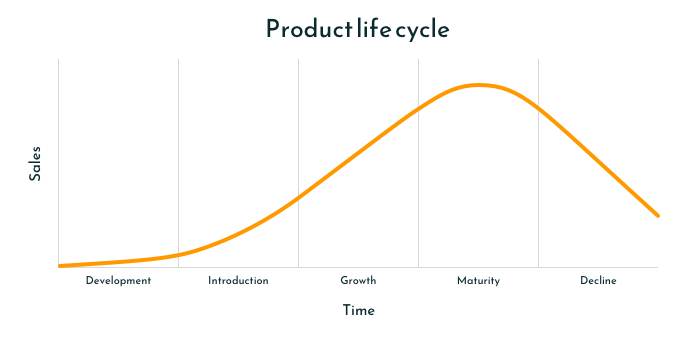Monday, March 20, 2023
Product life cycle in brief
The product life cycle is a concept that describes the stages a product goes through from its inception to its eventual demise.
Understanding the product life cycle is important for businesses to develop a strategy for successful marketing, sales, and profitability. It also helps to minimize costs and reduce waste.
In this article, we will look into all product life cycle stages.

Product Development
It all starts with product development.
This stage is usually skipped when people talk about the product life cycle. However, this is a core step where you develop a product or improve an existing one.
In this stage, businesses start with an idea, proof of concept, prototypes, and testing. Customer feedback is an essential part of the product development process.
Typically, this stage requires a lot of time and money. Businesses need to be aware of the costs and make sure that they have enough resources to move forward. Sometimes, businesses need to make hard decisions to stop products before they even go to the market.
While there are no sales typically happening, some businesses prefer to run pre-order to back up product development and attract early adopters.
Introduction
Once the product is ready, the next step in the product life cycle is the introduction.
This is where your product meets the market and you need to focus on building awareness and generating interest.
Businesses address potential customers with effective marketing that targets early adopters. Early adopters are customers who are open to new technologies and solutions. These people are more engaged and are more open to providing their input when it comes to feedback.
For products and businesses in the introduction stage, it is crucial to meet the needs of early adopters. This group acts as your product advocate and gives you a high Net Promoter Score (NPS).
Are you ready to build better products?
Growth
As your product starts to gain traction you are entering the growth stage.
In this stage, your sales start to increase and you can focus on expanding your distribution channels.
Businesses start to increase production and focus on meeting the needs of a wider audience.
In the growth stage, you constantly work on product improvements and look for ways to grow your marketing reach. Your investments in marketing grow as you cover more channels so as your expenses on running the business. With higher demand, you are more likely to boost your production or development which means hiring more people.
The growth stage is the only one you need to expand as much as possible.
Maturity
Your product is well-established on the market but it also means that it is entering the maturity stage.
In this stage, your sales growth begins to slow down and eventually see a decline.
In the maturity stage, businesses focus on maintaining their market share by retaining existing customers and finding new ones.
To prolong that stage, you need to invest in marketing to maintain awareness. It is also important to improve your product in order to stay competitive.
Decline
The decline is the final stage of your product life cycle.
This is where your sales start to plumb and the product becomes less profitable.
Many businesses struggle during the decline stage by not letting their product go. In this stage, though decisions should be made as you need to decide when you should stop maintaining your product.
A continuous investment can often lead to a business losing money by maintaining a product that can not generate enough revenue.
Conclusions
Understanding the product life cycle is important for running a successful business. It can help you minimize costs, develop efficient strategies for marketing and sales, and maximize products' life.
Product lifespan can vary depending on how smart businesses approach certain stages. It can also be affected by the industry, competitors, and market demands. To increase success, businesses need to keep a close eye on the product and work with customers to keep competitiveness.
Explore more
It’s time to start understanding your customers
Stop playing guesstimates. With Omnisome, you are building a lean feedback loop with your customers joining the game.
